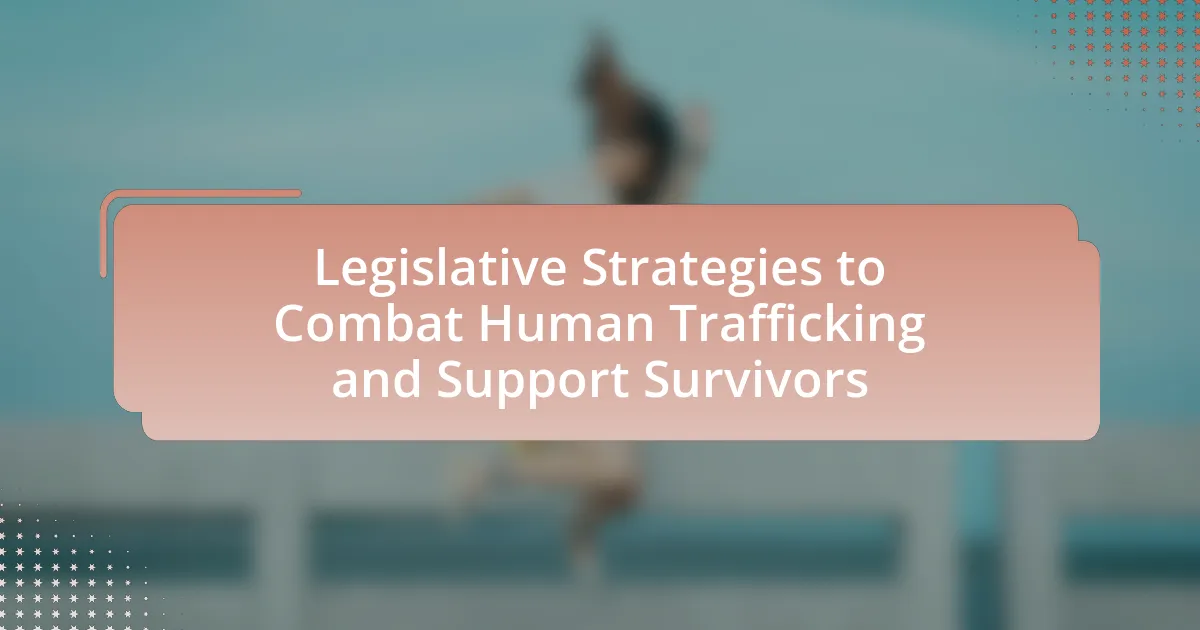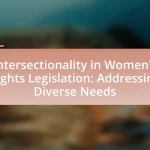Legislative strategies to combat human trafficking focus on enacting comprehensive laws that criminalize trafficking, enhance victim protection, and increase funding for support services. Key components of effective legislation include clear objectives, stakeholder engagement, data-driven decision-making, and robust enforcement mechanisms. The Trafficking Victims Protection Act (TVPA) serves as a pivotal example, establishing a framework for prevention, prosecution, and support for survivors. Challenges faced by legislators include political will, funding limitations, and varying state laws, while collaboration with NGOs and community stakeholders is essential for developing effective anti-trafficking measures. Future trends indicate a growing emphasis on international cooperation, technology integration, and comprehensive support services for survivors.

What are Legislative Strategies to Combat Human Trafficking and Support Survivors?
Legislative strategies to combat human trafficking and support survivors include enacting comprehensive laws that criminalize trafficking, enhancing victim protection measures, and increasing funding for support services. For instance, the Trafficking Victims Protection Act (TVPA) of 2000 established a framework for combating human trafficking in the United States, providing tools for law enforcement and resources for victims. Additionally, states have implemented laws that require training for law enforcement and service providers to identify and assist trafficking victims effectively. Research indicates that states with stronger anti-trafficking laws see higher rates of victim identification and support, demonstrating the effectiveness of these legislative measures.
How do these strategies address the issue of human trafficking?
Legislative strategies address the issue of human trafficking by establishing legal frameworks that criminalize trafficking activities and enhance victim protection. These laws create penalties for traffickers, thereby deterring potential offenders, while also providing resources and support systems for survivors, such as access to legal assistance and rehabilitation services. For instance, the Trafficking Victims Protection Act (TVPA) in the United States not only criminalizes human trafficking but also allocates funding for victim services, demonstrating a comprehensive approach to both prevention and support.
What are the key components of effective legislative strategies?
The key components of effective legislative strategies include clear objectives, stakeholder engagement, data-driven decision-making, and robust enforcement mechanisms. Clear objectives ensure that the legislative goals are specific and measurable, allowing for focused efforts against human trafficking. Stakeholder engagement involves collaboration with law enforcement, non-profits, and survivors to create comprehensive policies that address the complexities of trafficking. Data-driven decision-making relies on accurate statistics and research to inform legislation, ensuring that policies are based on evidence of what works. Robust enforcement mechanisms are essential to ensure compliance and accountability, which can be supported by historical examples such as the Trafficking Victims Protection Act of 2000, which established a framework for combating trafficking and has led to increased prosecutions and victim support services.
How do these components work together to combat trafficking?
Legislative strategies, law enforcement efforts, and victim support services work together to combat trafficking by creating a comprehensive framework that addresses prevention, prosecution, and protection. Legislative strategies establish laws that define trafficking offenses and set penalties, which empower law enforcement to investigate and prosecute traffickers effectively. For instance, the Trafficking Victims Protection Act (TVPA) provides federal resources and guidelines for combating trafficking, leading to increased arrests and convictions. Law enforcement collaborates with non-governmental organizations to identify victims and provide them with necessary support services, such as counseling and legal assistance, which are crucial for their recovery and reintegration. This multi-faceted approach ensures that all aspects of trafficking are addressed, from deterrence to victim support, thereby enhancing the overall effectiveness of anti-trafficking efforts.
Why is legislation important in the fight against human trafficking?
Legislation is crucial in the fight against human trafficking because it establishes legal frameworks that define trafficking, set penalties for offenders, and provide protections for victims. Effective laws enable law enforcement agencies to investigate and prosecute trafficking cases, thereby deterring potential traffickers. For instance, the Trafficking Victims Protection Act (TVPA) of 2000 in the United States has been instrumental in increasing awareness and resources dedicated to combating human trafficking, resulting in a significant rise in prosecutions and victim support services. Furthermore, comprehensive legislation facilitates international cooperation, allowing countries to work together to address cross-border trafficking issues, which is essential given the global nature of this crime.
What role does legislation play in prevention efforts?
Legislation plays a critical role in prevention efforts by establishing legal frameworks that define and criminalize human trafficking, thereby deterring potential offenders. Effective laws create clear penalties for traffickers, which can reduce the incidence of trafficking activities. For example, the Trafficking Victims Protection Act (TVPA) in the United States, enacted in 2000, provides a comprehensive approach to combat human trafficking through prevention, protection, and prosecution, leading to increased awareness and resources dedicated to fighting this crime. Additionally, legislation can facilitate collaboration among law enforcement, social services, and non-governmental organizations, enhancing the overall effectiveness of prevention strategies.
How does legislation support survivors of human trafficking?
Legislation supports survivors of human trafficking by establishing legal frameworks that provide protection, resources, and services to aid their recovery and reintegration. For instance, the Trafficking Victims Protection Act (TVPA) in the United States offers survivors access to critical services such as housing, medical care, and legal assistance, while also allowing them to apply for special visas that protect them from deportation. Additionally, laws often mandate training for law enforcement and service providers to recognize and assist trafficking victims effectively, ensuring that survivors receive the necessary support and are treated with dignity. These legislative measures are essential in creating a comprehensive approach to combat human trafficking and empower survivors to rebuild their lives.
What challenges do legislators face in combating human trafficking?
Legislators face significant challenges in combating human trafficking, primarily due to the complexity of the issue, lack of resources, and varying state laws. The complexity arises from the need to address multiple factors, including poverty, immigration, and demand for illicit services, which complicates the development of effective policies. Additionally, many legislators encounter insufficient funding and resources to implement comprehensive anti-trafficking programs, as highlighted by the U.S. Department of Justice, which reported that only a fraction of federal funding is allocated specifically for trafficking prevention and victim support. Furthermore, the inconsistency in state laws regarding trafficking creates gaps in enforcement and prosecution, making it difficult for legislators to create a unified national strategy.
What are the common obstacles in passing anti-trafficking laws?
Common obstacles in passing anti-trafficking laws include lack of political will, insufficient funding, and inadequate public awareness. Political will is often hindered by competing legislative priorities and differing views on the issue among lawmakers. Insufficient funding limits the ability to implement and enforce laws effectively, as resources are necessary for training law enforcement and supporting victims. Additionally, inadequate public awareness leads to a lack of pressure on legislators to prioritize anti-trafficking measures, resulting in minimal advocacy for stronger laws. These factors collectively impede the development and enactment of comprehensive anti-trafficking legislation.
How do political and social factors influence legislative efforts?
Political and social factors significantly influence legislative efforts by shaping public opinion, determining the priorities of lawmakers, and affecting the allocation of resources. For instance, heightened awareness of human trafficking due to social movements can lead to increased legislative action, as seen in the passage of the Trafficking Victims Protection Act in the United States, which was influenced by advocacy groups raising awareness about the issue. Additionally, political alignment and party agendas can dictate which issues receive attention; for example, bipartisan support for anti-trafficking measures often emerges during election cycles when candidates seek to appeal to constituents concerned about social justice. Furthermore, social factors such as demographic changes and cultural attitudes can impact the urgency and focus of legislative initiatives, as evidenced by the growing recognition of the need for survivor support services in response to changing societal views on victimization.
How can collaboration enhance legislative strategies?
Collaboration can enhance legislative strategies by fostering a multi-stakeholder approach that integrates diverse perspectives and expertise. This collective effort allows for the identification of comprehensive solutions to complex issues like human trafficking. For instance, partnerships between government agencies, non-profit organizations, and community groups can lead to more effective policy development and implementation, as evidenced by the success of initiatives like the Trafficking Victims Protection Act, which was strengthened through collaborative efforts among lawmakers, advocacy groups, and law enforcement. Such collaboration not only improves the quality of legislation but also ensures that it is more responsive to the needs of survivors and communities affected by trafficking.
What are the best practices for developing effective anti-trafficking laws?
The best practices for developing effective anti-trafficking laws include comprehensive legal frameworks that address prevention, protection, and prosecution. These laws should incorporate victim-centered approaches, ensuring that survivors receive necessary support and services, such as legal aid and rehabilitation. Additionally, effective anti-trafficking laws must promote interagency collaboration among law enforcement, social services, and non-governmental organizations to facilitate information sharing and coordinated responses.
Evidence from the United Nations Office on Drugs and Crime indicates that countries with robust anti-trafficking legislation that includes these elements experience higher rates of victim identification and successful prosecutions. Furthermore, regular training for law enforcement and judicial officials on trafficking issues enhances the enforcement of these laws, as shown in various case studies where targeted training led to improved outcomes in trafficking cases.
How can stakeholder engagement improve legislative outcomes?
Stakeholder engagement can significantly improve legislative outcomes by fostering collaboration and ensuring that diverse perspectives are considered in the policymaking process. Engaging stakeholders, such as survivors, advocacy groups, and law enforcement, leads to more informed legislation that addresses the complexities of human trafficking. For instance, research by the National Conference of State Legislatures indicates that inclusive stakeholder input results in laws that are more effective and better aligned with community needs. This collaborative approach not only enhances the legitimacy of the legislative process but also increases the likelihood of successful implementation and compliance with the laws enacted.
What role do NGOs play in shaping legislative strategies?
NGOs play a critical role in shaping legislative strategies by advocating for policy changes, providing expert knowledge, and mobilizing public support. They influence lawmakers through research, data collection, and case studies that highlight the impact of human trafficking, thereby informing legislative priorities. For instance, organizations like Polaris have successfully lobbied for the Trafficking Victims Protection Act, which established comprehensive measures against trafficking. Additionally, NGOs often collaborate with government agencies to develop effective strategies and ensure that survivor voices are included in the legislative process, enhancing the relevance and effectiveness of laws aimed at combating human trafficking.
What specific legislative measures have proven effective in combating human trafficking?
The Trafficking Victims Protection Act (TVPA) has proven effective in combating human trafficking by establishing a comprehensive framework for prevention, protection, and prosecution. Enacted in 2000, the TVPA provides federal funding for victim services, mandates the creation of a national human trafficking hotline, and requires the federal government to assess and report on trafficking efforts. Additionally, the law enhances penalties for traffickers and encourages states to adopt similar measures, leading to increased awareness and enforcement. According to the U.S. Department of Justice, the TVPA has contributed to the identification and assistance of thousands of trafficking victims since its implementation.
What are the most successful laws enacted in recent years?
The most successful laws enacted in recent years to combat human trafficking include the Trafficking Victims Protection Act (TVPA) reauthorization in 2018 and the Allow States and Victims to Fight Online Sex Trafficking Act (FOSTA) of 2018. The TVPA has been instrumental in providing resources for victim assistance and enhancing law enforcement’s ability to prosecute traffickers, leading to increased convictions. FOSTA has empowered states to take legal action against online platforms facilitating sex trafficking, resulting in significant reductions in such activities on major websites. These laws have been validated by a reported increase in victim identification and a decrease in online exploitation cases, demonstrating their effectiveness in addressing human trafficking.
How do these laws impact the lives of survivors?
Laws designed to combat human trafficking significantly improve the lives of survivors by providing them with legal protections and access to essential services. These laws often include provisions for victim assistance, such as access to healthcare, counseling, and legal aid, which are crucial for recovery and reintegration into society. For instance, the Trafficking Victims Protection Act (TVPA) in the United States establishes a framework for identifying victims and ensuring they receive necessary support, which has led to increased reporting and assistance for survivors. Additionally, these laws create a legal pathway for survivors to seek justice against their traffickers, empowering them and fostering a sense of agency in their recovery process.
What future trends can be anticipated in legislative strategies against human trafficking?
Future trends in legislative strategies against human trafficking will likely focus on enhanced international cooperation, increased use of technology for tracking and reporting, and more comprehensive victim support services. Legislative bodies are expected to strengthen cross-border collaboration to address the global nature of trafficking, as evidenced by initiatives like the United Nations’ Global Action Plan to Combat Trafficking in Persons. Additionally, the integration of data analytics and artificial intelligence in law enforcement will facilitate better identification of trafficking patterns and victims, as highlighted by the use of technology in recent anti-trafficking campaigns. Furthermore, there is a growing emphasis on holistic approaches that not only penalize traffickers but also provide extensive support for survivors, including mental health services and job training programs, reflecting a shift towards recognizing the long-term needs of victims.
How might technology influence future legislative efforts?
Technology will significantly influence future legislative efforts by enhancing data collection, improving communication, and facilitating real-time monitoring of human trafficking activities. For instance, advanced data analytics can help lawmakers identify trafficking patterns and hotspots, enabling targeted interventions. Additionally, technology platforms can streamline communication between law enforcement, NGOs, and government agencies, fostering collaboration and information sharing. A study by the International Organization for Migration highlights that the use of mobile applications and online reporting tools has increased the reporting of trafficking cases by 30%, demonstrating how technology can empower stakeholders and inform legislative frameworks.
What emerging issues should legislators be aware of?
Legislators should be aware of the increasing use of technology in human trafficking, particularly through online platforms and social media. The National Center for Missing and Exploited Children reported a 98% increase in online enticement cases from 2019 to 2020, highlighting the need for updated regulations and enforcement strategies. Additionally, the rise of cryptocurrency in illicit transactions complicates tracking and prosecution efforts, necessitating legislative action to address these evolving methods of trafficking.
What practical steps can be taken to strengthen legislative strategies against human trafficking?
To strengthen legislative strategies against human trafficking, governments should implement comprehensive laws that criminalize all forms of trafficking, enhance victim protection measures, and establish robust enforcement mechanisms. Comprehensive laws should include provisions for prevention, prosecution, and protection, ensuring that all forms of trafficking, including labor and sexual exploitation, are addressed. Victim protection measures must include access to legal assistance, healthcare, and social services, which are crucial for recovery and reintegration. Additionally, robust enforcement mechanisms, such as specialized training for law enforcement and collaboration with NGOs, can improve the identification and prosecution of traffickers. According to the U.S. Department of State’s Trafficking in Persons Report, countries with strong legal frameworks and enforcement mechanisms see higher rates of trafficking prosecutions and victim support, demonstrating the effectiveness of these legislative strategies.


